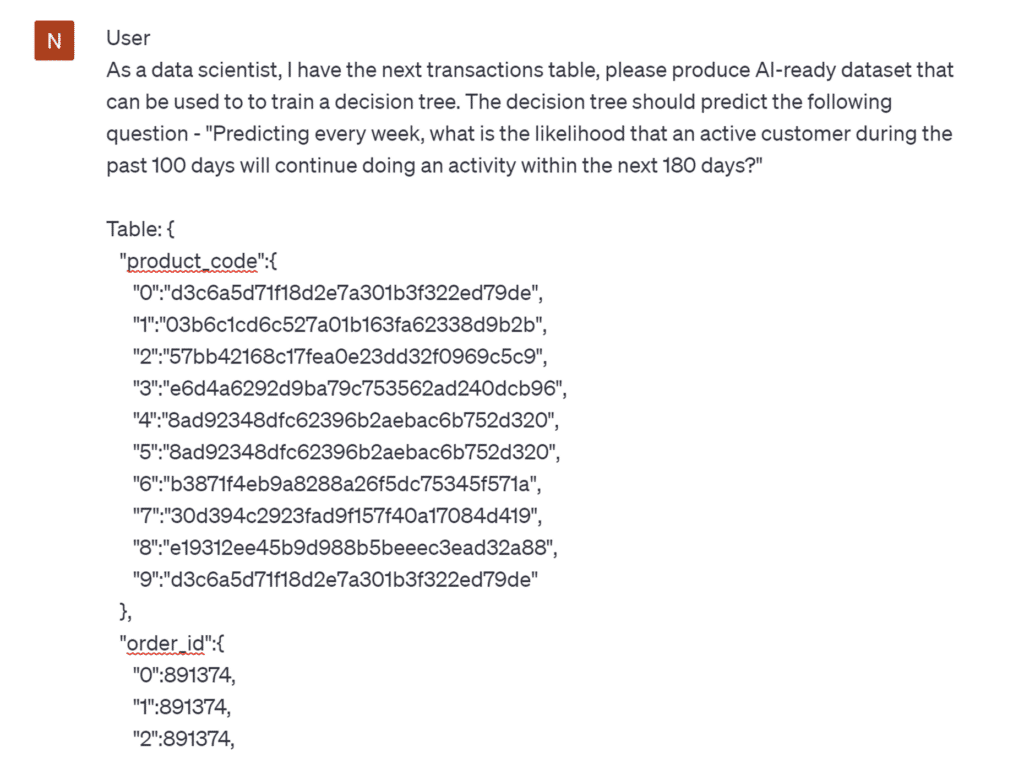- In a nutshell:Large Language Models (LLMs) are AI models trained on vast amounts of text data to understand and generate human language.
- LLMs excel at processing and understanding unstructured data, specifically text, and can generate coherent and context-specific text.
- LLMs are part of AI innovation and have practical applications in customer service, content creation, healthcare, and more.
- LLMs work together with predictive AI to provide a more advanced and personalized AI experience, as in Pecan's Predictive GenAI.
- The future of LLMs in AI holds tremendous potential for personalization, content creation, customer service, and healthcare, among other areas.
If you're a data professional — or even just a data enthusiast — you know that learning new things in this field never ends. It's a blessing and a curse; there's always something new and exciting happening, but trying to keep up can be exhausting. You might be feeling that way right now with LLMs and AI. Artificial intelligence (AI) has become invaluable to many industries at this point. Its ability to analyze vast amounts of data and make predictions has revolutionized everything from healthcare to finance to retail to software. Of course, the latest AI innovation to gain sustained attention is Large Language Models (LLMs), one form of generative AI. LLMs have the potential to unlock new possibilities and transform the way we approach AI technology. In this article, we'll explore the role of LLMs in AI innovation and especially how they intersect with predictive AI — the tried-and-true machine learning methods that have shaped AI to this point. By understanding their significance and future prospects, data analysts and data leaders can harness the power of LLMs to improve their AI solutions. Understanding LLMs
At a basic level, Large Language Models (LLMs) are AI models that have been trained on a vast amount of text data. They are designed to understand, generate, and engage with human language in a meaningful way.
Detailed Explanation of What LLMs Are
LLMs are a type of artificial intelligence that uses machine learning algorithms to process, understand, and generate human language. They are trained on vast amounts of text data, and they 'learn' patterns within this data to predict what comes next in a piece of text. This predictive capability allows them to generate human-like text, whether it's completing a sentence, writing a paragraph, or even constructing an entire article.
How LLMs Differ from Traditional Machine Learning
While traditional machine learning models, like decision trees or neural networks, are often used to analyze numerical or tabular data, LLMs specialize in language data. The fundamental difference lies in the type and nature of the data they handle. Traditional machine learning models function well with structured data, whereas LLMs excel at processing and understanding unstructured data—namely, text. LLMs are designed to 'understand' the intricacies of human language—from semantics and syntax to context and sentiment.
Is GPT an LLM?
Generative Pre-trained Transformer (GPT) models specialize in text generation and completion, representing one type of Large Language Model (LLM). GPTs demonstrate remarkable proficiency in text generation and completion, along with various other language-oriented challenges. However, it's important to note that the broader category of Large Language Models (LLMs) encompasses diverse architectures like Transformers, RNNs (Recurrent Neural Networks), and CNNs (Convolutional Neural Networks). Each of these types is designed to achieve specific language model objectives.While GPT models can be classified as LLMs, not all LLMs share the GPT architecture.
How LLMs Represent Part of Today's AI Innovation
LLMs are transformative in the realm of AI innovation. Whereas traditional machine learning models analyze data and make predictions, LLMs take it a step further. They not only understand and predict language but also generate it. This capability to generate coherent, relevant, and context-specific text sets LLMs apart, paving the way for more advanced and interactive AI models. The potential of LLMs in AI innovation is vast, from improving human-computer interactions to fostering creativity and efficiency in numerous sectors such as customer service, content creation, and more.
The Significance of LLMs in AI Innovation
The unique capabilities of LLMs contribute extensively to AI technology, charting the course towards an AI-enhanced future.
How LLMs Contribute to AI Technology
The unique abilities of LLMs to understand, predict, and generate human language hold immense potential. Unlike traditional machine learning models that provide results based on numerical data, LLMs can comprehend and interact with human language data with unprecedented sophistication. This means that the technology is no longer simply responding to user inputs but proactively participating in interactions. LLMs can provide context-specific responses, ask pertinent follow-up questions, and even generate creative and insightful content. Therefore, they enhance the adaptive and dynamic nature of AI systems, facilitating more interactive, user-friendly, and intelligent interfaces.
What is the difference between NLP and LLM?
Natural Language Processing (NLP) is an AI branch focused on comprehending and processing human language. While NLP covers diverse language processing techniques, LLMs represent a specific model category within NLP. Within NLP, Large Language Models (LLMs) stand out for their exceptional performance in language-related tasks, characterized by their substantial size and text generation capabilities. These models, trained on extensive data (hence the "large" label), exhibit the ability to produce coherent and contextually relevant text based on input. This ability makes them useful for tasks like language translation, text generation, question answering, and sentiment analysis.
LLMs and Their Role in Personalization
Another key aspect of LLMs is their potential to support personalization in AI technology. Each individual has a unique way of expressing themselves, and LLMs can handle this diversity. For instance, by learning from the unique language style and word choice of a person, LLMs can help in developing AI systems that provide highly personalized and relevant suggestions or responses, or even content creation (as found in AI tools for marketers). Similarly, in the realm of customer service, LLMs can be trained to understand a customer’s unique preferences and needs based on their way of interacting. This can lead to improved customer experiences, as the answers and help provided will be more aligned with the customer’s unique context and preferences. Furthermore, LLMs can assist in designing advertisements or product recommendations that are highly targeted based on the understanding of the user's language and expressions. This could play a significant role in AI marketing strategies, making them more effective and customer-centric. This aspect of LLMs can significantly enhance the user experience and open up new avenues in the personalization of AI technology.
Examples of Practical Applications Where LLMs Have Spurred Innovation
The wonders of LLMs aren't confined to theory. They're already being utilized in tangible, innovative applications across industries. For instance, in the customer service sector, LLMs are used to power sophisticated chatbots that understand a customer’s query and respond with relevant information, greatly enhancing customer experiences. In the sphere of content creation, LLMs can generate articles, blog posts, and other types of content, freeing up time for human creators to focus on more strategic tasks. They have also been used in translation services, providing high-quality translation that takes into account not just word-for-word translation but also the context and subtleties of the language. Even in the healthcare sector, LLMs are making strides. They're used to analyze and understand medical documents, patient records, and research papers, providing valuable insights and potentially helping with prognosis and treatment plans. These practical applications demonstrate the versatility and potential of large language models in contributing to AI innovation, proving that they're much more than just a theoretical concept. They are an integral part of the AI narrative, shaping our technological landscape and redefining the interactions between humans and machines.
Relationship between Generative AI (LLMs) and Predictive AI
As we continue our exploration of the role of LLMs in AI, it's important to understand the relationship between generative AI (including LLMs) and predictive AI. Both play a vital role in AI technology, but they do so in distinct ways. Understanding their unique contributions and how they complement each other will provide a holistic view of the AI landscape.
Distinction Between Generative AI and Predictive AI
Generative AI, particularly as embodied by Large Language Models, is primarily concerned with understanding language and generating output that mirrors humans' natural language in complexity and relevance. It excels at tasks like generating a sentence or an entire paragraph. Predictive AI, on the other hand, is more numerically oriented in nature. It analyzes past data trends to make future predictions and excels at working with structured data. It might predict future sales numbers based on past trends, for instance.
In essence, while generative AI focuses on creating something new, predictive AI uses information from the past to predict the future. This doesn’t mean that one is superior to the other—they are simply different tools in the AI toolbox, each with their own strengths and applications.
How Generative AI (LLMs) and Predictive AI Work Together to Boost AI Technology
Despite their differences, generative AI and predictive AI can work in tandem to provide an enriched AI experience. For example, an AI chatbot might use predictive AI to anticipate a user's needs based on their past interactions and then use large language models to generate an appropriate, personalized response. In this scenario, predictive AI and generative AI are not adversaries but allies, working together to provide a better, more human-like interaction. This synergy is a prime example of AI innovation, showing that the combination of different AI methodologies can lead to more advanced and effective solutions. Through this integration, AI can reach new heights, taking us closer to a time where AI isn't just a tool but a proactive participant in our interactions. This not only improves the AI experience but also breeds innovation and progress, pushing the boundaries of what AI can achieve. As we transition towards an AI-centric future, it becomes increasingly important for data analysts and leaders to understand the distinct yet interconnected roles that LLMs and predictive AI play in this landscape. Harnessing their combined power can unlock a multitude of possibilities, paving the way for unprecedented advancements in AI technology, and that's exactly what we aim to do at Pecan AI. (You can check out how we're doing that by taking a look at our platform.)
LLMs and Future Prospects in AI
The use of LLMs in AI may still be in its infancy, but their potential is tremendous. As AI continues to mature and become more sophisticated, we can expect LLMs to play an increasingly important role.
How LLMs are Expected to Shape the Future of AI
In the future, LLMs could revolutionize areas such as personal assistants, content creation, customer service, and healthcare, among others, by offering more advanced and personalized services. For example, they could be used to create virtual personal assistants that understand the context of a user's requests, answering questions and offering suggestions in a more human-like manner. In the realm of content creation, large language models could be used to generate high-quality content for a variety of topics, adapting to the user's writing style and preferences. This would not only streamline the content creation process but also allow for a higher level of customization and personalization. Furthermore, in customer service, LLMs could provide more accurate and context-specific responses, improving customer satisfaction and the effectiveness of support. In healthcare, LLMs could analyze medical documents and patient histories more accurately, leading to better patient outcomes.
How Pecan AI Plans to Stay Ahead with LLMs in AI Innovation
At Pecan AI, we recognize the vast potential that both predictive and generative AI, specifically LLMs, hold for the future of AI. Our Predictive GenAI capabilities leverage the power of LLMs to support predictive modeling for data analysts and other data professionals. This powerful synergy of predictive and generative AI allows us to provide more advanced and effective AI solutions, offering valuable insights and empowering businesses to make data-driven decisions. By harnessing the power of LLMs, we aim to stay at the forefront of AI innovation, shaping the future of AI technology.
Challenges and Potential Strategies in Implementing LLMs
While the transformative potential of large language models is well recognized, they also present unique challenges that need to be addressed to harness their full power. One of the main challenges is understanding the contextual and cultural nuances of human language. Processing language is just the first step, but correctly interpreting the underlying semantics and cultural references is vital for offering accurate and relevant responses or generations. Another challenge is ensuring the ethical use of AI language technologies. AI systems, including LLMs, can inadvertently propagate bias that may be present in their training data. It's imperative to develop and implement strategies for fairness, transparency, and accountability in AI systems to mitigate these risks. Strategies to overcome these challenges could include investing in domain-specific training for these models to enhance their understanding of context and cultural nuances. Moreover, continuous learning and adaptation built into these models can help improve their responsiveness and relevance over time. In terms of ethical concerns, it's essential to adopt practices like responsible AI and ethical AI, which involve building AI systems that are fair, transparent, accountable, and that respect privacy. Techniques such as differential privacy, federated learning, and explainable AI can be leveraged to address some of these concerns. The road to AI innovation with large language models is filled with potential. However, it also calls for responsible and thoughtful advances and strategies to fully realize this potential without compromising on ethical concerns.
Future Developments in LLMs
As we look toward the future, advancements and refinements in LLMs are expected. There is ongoing work focused on reducing their size without compromising the quality of their output. This could make LLMs more accessible for integration into various applications and platforms, expanding their reach and usability. Moreover, the development of more targeted large language models is anticipated. These could be designed to specialize in specific industries or types of data, driving even more accurate interactions and insights. This approach can lead to breakthroughs in fields where precision is key, such as medicine or law. Finally, advancements in the interpretability of LLMs are also being studied. Making the workings of these models more transparent could not only improve trust in their outputs but also enable more effective troubleshooting and fine-tuning of the models. These potential advancements demonstrate that LLMs are far from a completed technology; rather, they are a rapidly evolving field with many exciting developments yet to come.
Importance of LLMs in AI Innovation
The importance and role of large language models in AI innovation cannot be overstated. They provide a way for AI to understand, generate, and interact with human language in a more advanced and sophisticated manner than traditional machine learning models. We encourage data analysts and data leaders to leverage the power of LLMs to improve their AI solutions. By harnessing the combined power of predictive and generative AI, we can unlock a multitude of possibilities, paving the way for unprecedented advancements in AI technology. (Check out some ideas from our co-founder and CEO about this potential.) At Pecan AI, we are excited about the future of AI and are committed to harnessing the power of LLMs to drive innovation and progress in this exciting field. We invite you to join us on this journey towards an AI-enhanced future with a free trial of our platform, where you can start predictive modeling with an LLM-powered chat.







